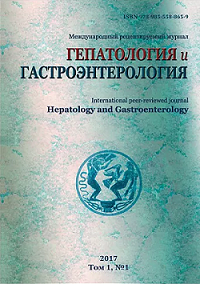INTERFERON-FREE THERAPY IN PATIENTS WITH CHRONIC HEPATITIS C IN REAL CLINICAL PRACTICE
Abstract
Background. Antiviral 3D therapy for chronic hepatitis C has several advantages over treatment regimens, including pegylated interferons: a high degree of eradication of the virus, less pronounced side effects and a low risk of developing resistance.
Objective. To evaluate the effectiveness and safety of antiviral 3D therapy in patients with chronic hepatitis C, genotype 1 infection.
Materiasl and methods. The study involved 50 patients with chronic hepatitis C, genotype 1 infection. The mean age was 50.58±8.7 years. The average viral load of patients before the onset of 3D therapy was 4.45*10*5 ± 2.2 IU/mL. All patients were prescribed non-interferon triple therapy with paritoprevir, ombitasvir, dasabuvir for 12 weeks.
Results. Monitoring of the virological effectiveness of 3D therapy 30 days after the beginning of treatment revealed the cessation of viral replication in 90% of patients. After 60 days, all patients had a virologic response. At the end of therapy, after 90 days, the absence of viral load was detected in 96% of patients. At 12 and 24 weeks after completion of treatment, 96% of patients had a sustained virologic response. Side effects were moderately expressed and had a short-term character.
Conclusion. As a result of antiviral 3D therapy in patients with chronic hepatitis C, a stable virologic response was obtained in 96% of cases.
References
1. Baranov, A. V. Epidemiologicheskije i klinicheskije osobennosti hronicheskogo gepatita C [Epidemiological and clinical features of chronic hepatitis C] / A. V. Baranov, V. V. Maleev // Epidemiology and Infectious Diseases. – 2008. – № 2. – S. 32-35. (Russian)
2. Thomas, D. L. Natural history of hepatitis C / D. L. Thomas, L. B. Seeff // Clin. Liver. Dis. – 2005. – Vol. 9, № 3. – P. 383-398.
3. Bondarenko, A. L. Sovremennyje problemy diagnostiki I lechenija hronicheskih virusnyh gepatitov [Modern problems of diagnosis and treatment of chronic viral hepatitis] / A. L. Bondarenko // Medical Newsletter of Vyatka. – 2006. – № 2. – S. 41-42. (Russian)
4. Evolution of hepatitis C virus NS5A region in breakthrough patients during pegylated interferon and ribavirin therapy / H. J. Yuan [et al.] // J. Viral. Hepat. – 2015. – Vol. 17, № 3. – P. 208-216. – DOI: 10.1111/j.1365-2893.2009.01169.x.
5. Farnik, H. New antiviral therapies in themanagement of HCV infection / H. Farnik, S. Zeuzem // Antivir. Ther. – 2012. – Vol. 17, № 5. – P. 771-783. – DOI: 10.3851/IMP2127.
6. Grigorenko, E. I. Ocenka prediktorov stojkogo virusologicheskogo otveta i individualizacija terapii hronicheskogo gepatita C na sovremennom etape [Evaluation of predictors of sustained virological response and individualization of chronic hepatitis C therapy at the present stage] / E. I. Grigorenko // Crimean Journal of Internal Diseases. – 2012. – № 2. – S. 70-75. (Russian)
7. Asratjan, A. A. Tendencii i analiz epidemicheskoj situacii po parenteral'nym virusnym gepatitam B i C v RF i otdel'nyh regionah [Tendency and analysis of the epidemic situation for parenteral viral hepatitis B and C in Russian Federation and certain regions] / A. A. Asratjan, O. V. Isaeva M. I. Mihajlov // Zhurnal mikrobiologii, epidemiologii i immunologii. – 2005. – № 4. – S. 40-45. (Russian)
8. Kalinina, O. V. Strukturno-funktsional'naja organizacija genoma i zhiznennyj cikl virusa gepatita C [Structural and functional organization of the genome and life cycle of the hepatitis C virus] / O. V. Kalinina, A. V. Dmitriev // Molecular Genetics, Microbiology and Virology. – 2015. – № 2. – S. 9-13. (Russian)
9. Treatment of HCV with ABT-450/r-ombitasvir and dasabuvir with ribavirin / J. J. Feld [et al.] // N. Engl. J. Med. – 2014. – Vol. 370, № 17. – P. 1594-1603. – DOI: 10.1056/NEJMoa1315722.
10. Retreatment of HCV with ABT-450/r–o-bitasvir and dasabuvir with ribavirin / S. Zeuzem [et al.] // N. Engl. J. Med. – 2014. – Vol. 370, № 17. – P. 1604-1614. – DOI: 10.1056/NEJMoa1401561.
11. Exploratory Study of oral combination antiviral therapy for hepatitis C / F. Poordad [et al.] // N. Engl. J. Med. – 2013. – Vol. 368, № 1. – P. 45-53. – DOI: 10.1056/NEJMoa1208809.


















1.png)






